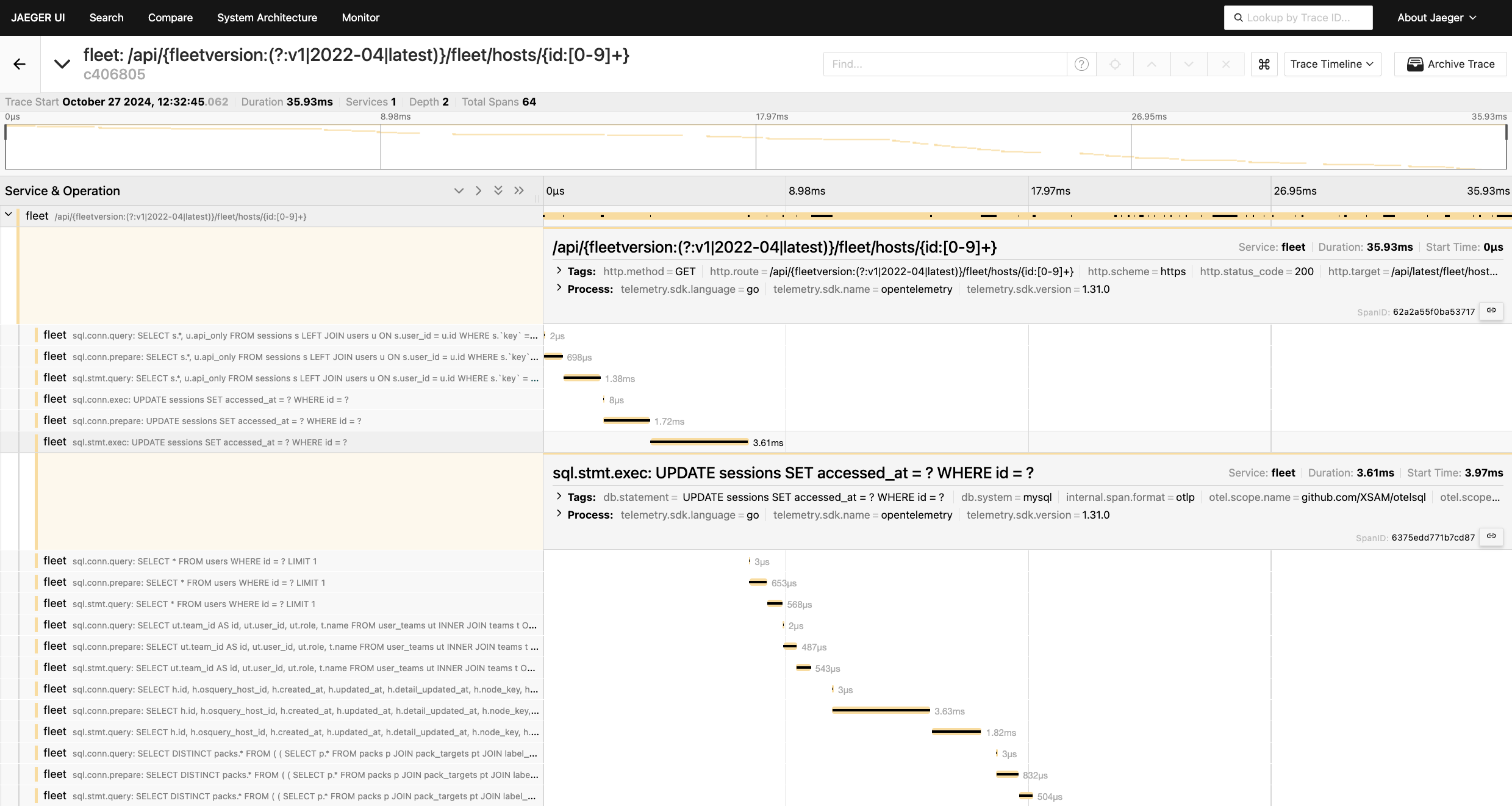This article discusses our first impressions of using OpenTelemetry with Jaeger.
What is OpenTelemetry?
OpenTelemetry is a set of APIs, libraries, agents, and instrumentation for collecting distributed traces and metrics from your applications. It provides a standardized way to instrument your code and collect telemetry data. OpenTelemetry supports programming languages like Java, Python, Go, JavaScript, etc.
Tracing is a method of monitoring and profiling your application to understand how requests flow through your system. For example, you can view the associated database calls and requests to other services for a single API request. Tracing allows you to identify bottlenecks, latency issues, and other performance problems.
What is Jaeger?
Jaeger is an open-source, end-to-end distributed tracing system. Jaeger is popular for tracing applications because of its scalability, ease of use, and integration with other tools. Jaeger provides a web-based UI for viewing traces and analyzing performance data.
Add OpenTelemetry instrumentation to your application
To start with OpenTelemetry and Jaeger, you must instrument your application with OpenTelemetry libraries.
In our case, we used the OpenTelemetry Go SDK to instrument our Go application. We added the necessary dependencies to our project.
go get go.opentelemetry.io/otel@v1.31.0
go get go.opentelemetry.io/otel/exporters/otlp/otlptrace@v1.31.0
go get go.opentelemetry.io/otel/exporters/otlp/otlptrace/otlptracegrpc@v1.31.0
go get go.opentelemetry.io/otel/sdk@v1.31.0
go get go.opentelemetry.io/contrib/instrumentation/github.com/gorilla/mux/otelmux@v0.56.0
go get github.com/XSAM/otelsql@v0.35.0
The go.opentelemetry.io/contrib/instrumentation/github.com/gorilla/mux/otelmux package is needed to instrument our
gorilla/mux HTTP router.
r := mux.NewRouter()
r.Use(otelmux.Middleware("fleet"))
The github.com/XSAM/otelsql package is needed to instrument our SQL database queries.
// ...
import "github.com/XSAM/otelsql"
import semconv "go.opentelemetry.io/otel/semconv/v1.26.0"
// ...
var otelTracedDriverName string
func init() {
var err error
otelTracedDriverName, err = otelsql.Register("mysql",
otelsql.WithAttributes(semconv.DBSystemMySQL),
otelsql.WithSpanOptions(otelsql.SpanOptions{
// DisableErrSkip ignores driver.ErrSkip errors, which are frequently returned by the MySQL
// driver when certain optional methods or paths are not implemented/taken.
// For example, interpolateParams=false (the secure default) will not do a parametrized
// sql.conn.query directly without preparing it first, causing driver.ErrSkip
DisableErrSkip: true,
// Omitting span for sql.conn.reset_session since it takes ~1us and doesn't provide useful
// information
OmitConnResetSession: true,
// Omitting span for sql.rows since it is very quick and typically doesn't provide useful
// information beyond what's already reported by prepare/exec/query
OmitRows: true,
}),
// WithSpanNameFormatter allows us to customize the span name, which is especially useful for SQL
// queries run outside an HTTPS transaction, which do not belong to a parent span, show up as their
// own trace, and would otherwise be named "sql.conn.query" or "sql.conn.exec".
otelsql.WithSpanNameFormatter(func(ctx context.Context, method otelsql.Method, query string) string {
if query == "" {
return string(method)
}
// Append query with extra whitespaces removed
query = strings.Join(strings.Fields(query), " ")
if len(query) > 100 {
query = query[:100] + "..."
}
return string(method) + ": " + query
}),
)
if err != nil {
panic(err)
}
}
Then, use otelTracedDriverName to open a connection to your database.
db, err := sql.Open(otelTracedDriverName, "user:password@tcp(localhost:3306)/database")
When starting your application, you must create an OpenTelemetry exporter and a trace provider.
ctx := context.Background()
client := otlptracegrpc.NewClient()
otlpTraceExporter, err := otlptrace.New(ctx, client)
if err != nil {
panic("Failed to initialize tracing")
}
batchSpanProcessor := trace.NewBatchSpanProcessor(otlpTraceExporter)
tracerProvider := trace.NewTracerProvider(trace.WithSpanProcessor(batchSpanProcessor))
otel.SetTracerProvider(tracerProvider)
Launch Jaeger
To view traces, you need to launch Jaeger. You can run Jaeger locally using Docker. Based on the Jaeger 1.62 Getting Started guide, you can run the following command:
docker run --rm --name jaeger \
-p 16686:16686 \
-p 4317:4317 \
jaegertracing/all-in-one:1.62.0
In our example, we are only exposing two ports:
4317for the Jaeger collector, which receives trace data using OpenTelemetry Protocol (OTLP) over gRPC16686for the Jaeger UI
Launch your application
Before starting your application, you must set the OpenTelemetry endpoint to send traces to Jaeger. For example:
export OTEL_SERVICE_NAME=fleet
export OTEL_EXPORTER_OTLP_ENDPOINT=http://localhost:4317
Now, you can start your application.
View traces in Jaeger
Open your browser and navigate to http://localhost:16686 to view traces in the Jaeger UI. Select your Service name and click Find Traces.
You can click into a trace to view the details of each span. You can see the duration, logs, and tags for each span. The example below shows the HTTP request details and multiple SQL queries.

Use cases for OpenTelemetry and Jaeger
In a local software development environment, OpenTelemetry and Jaeger can be used to:
- Fix bottlenecks and latency issues
- Understand how requests flow through your system
If a bottleneck is known or suspected, Jaeger can help you identify the root cause. For example, you can see which database queries are taking the most time and optimize them.
When developing new features, Jaeger can help you understand how requests flow through your system. This telemetry data provides a quick check to ensure your new feature works as expected.
In a production environment, OpenTelemetry and Jaeger can be used to:
- Monitor and profile your applications
- Troubleshoot performance issues
- Optimize your applications and improve user experience
- Ensure your applications meet service level objectives (SLOs)
Problems with OpenTelemetry and Jaeger
OpenTelemetry and Jaeger are powerful tools, yet their development use seems limited to fixing performance bottlenecks. They cannot be used for general debugging out of the box since they don’t provide enough detail for each specific request, such as the request body.
In addition, missing spans can be a problem. If your application is not instrumented correctly, you may not see all the spans you expect or know about in Jaeger. Our application lacks spans for some API endpoints, Redis transactions, outbound HTTP requests, and asynchronous processes. Adding all of these spans requires additional development and QA efforts.
The Jaeger UI itself is basic and lacks some features. For example, regex search is missing out of the box, unless Elasticsearch/OpenSearch storage is added.
Our chosen SQL instrumentation library, github.com/XSAM/otelsql, could be better. It does not provide a way to trace the transaction lifecycle, and it creates many spans at the root level, clogging the Jaeger UI.
Further reading
OpenTelemetry: A developer’s best friend for production-ready code
How we changed our minds about OpenTelemetry and now advocate for developers to use it during development.Top 5 metrics for software load testing performance
Essential metrics to track when evaluating your application’s performance under load.How to benchmark performance of Go serializers
Learn effective techniques for measuring and optimizing Go code performance.
Example code on GitHub
Fleet Device Management repo with OpenTelemetry instrumentation (as of this writing)
Watch OpenTelemetry with Jaeger video
Note: If you want to comment on this article, please do so on the YouTube video.
